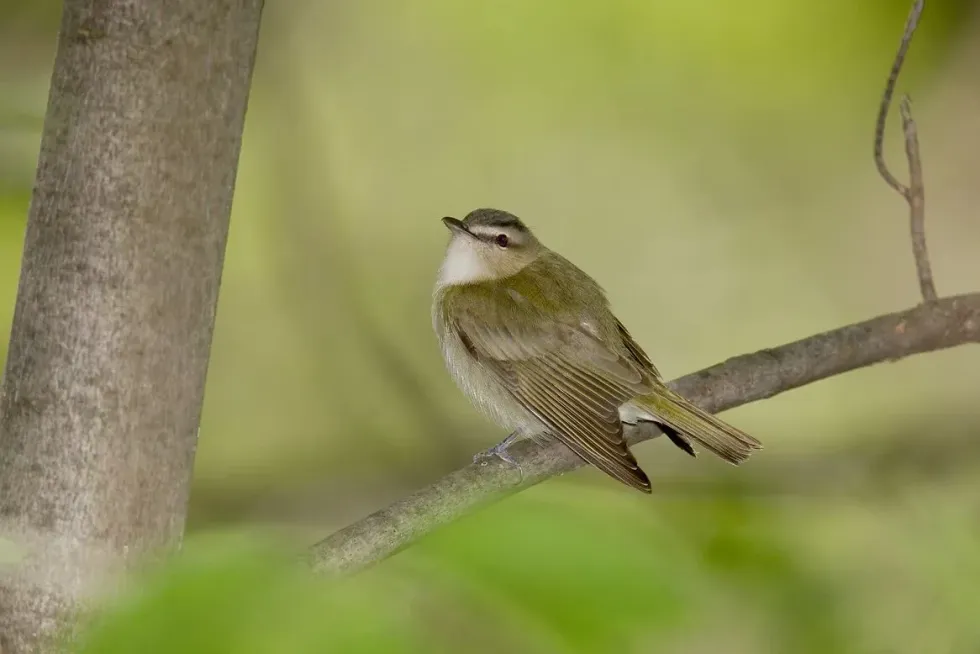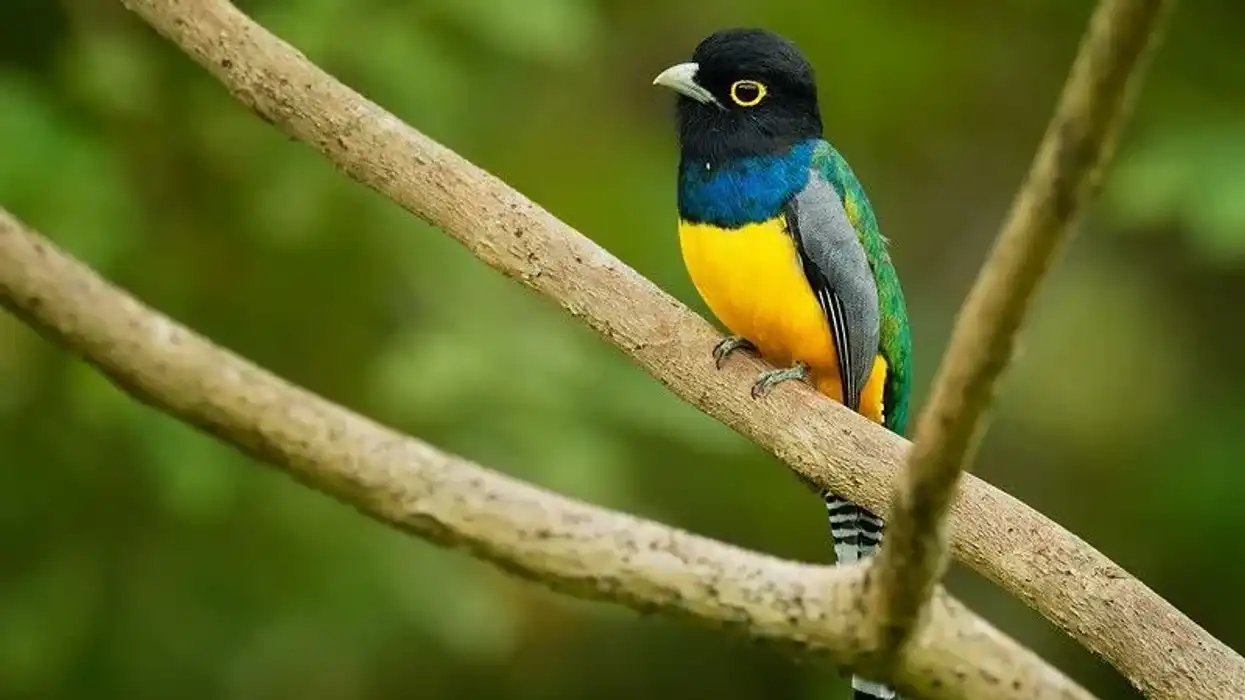A red-eyed vireo (Vireo olivaceus) is defined as a North American vireo bird that is olive green in color. They carry out the migration to wintering grounds, in large numbers, in South America. Their phylum is chordates.
They belong to the Vireonidae family. The red-eyed vireo's class is Aves and the red-eyed vireo genus is Vireo. These birds belong to the order Passeriformes.
Red-eyed vireo subspecies are called yellow-green vireo and Noronha vireo. These species of birds feed on insects and berries. These species of birds are most commonly found in forest habitats.
Red-eyed vireos can fly up to a height of 1,600 meters above sea level. Infant red-eyed vireo birds are young and hence stay in the red-eyed vireo nest, on the trees, until the fledgling. The red-eyed vireo's diet comprises a wide variety of insects found in its natural habitat.
A red-eyed vireo in flight looks majestic. Red-eyed vireo calls cannot be pinpointed due to their large number of songs.
The breeding season of red-eyed vireos is in summer from April to August; they lay eggs in North America. The nests of red-eyed vireos are compact and are made up of dried grass, twigs, strips of barks, weed, spiderwebs, cocoons, etc.
After reading these interesting red-eyed vireo facts, do check our other articles on the sturgeon and the brown trout as well.
Red-eyed Vireo Interesting Facts
What type of animal is a red-eyed vireo?
A red-eyed vireo is an American songbird of order Passeriformes. As the name suggests, these vireos have cute red eyes, which look adorable and make them appear like angry birds.
What class of animal does a red-eyed vireo belong to?
A red-eyed vireo belongs to the Aves class of animal kingdom and prefers living in rainforests, forest edge, plantations, and second-growth forests.
How many red-eyed vireos are there in the world?
There are 180 million red-eyed vireos in the world; most of which are in the United States.
Where does a red-eyed vireo live?
A red-eyed vireo's nests are found in trees, in the forests, in large numbers. They live together like a family.
What is a red-eyed vireo's habitat?
Red-eyed vireos prefer forests for their habitat. Red-eyed vireo birds’ nests are seen in trees, shrubs, rainforests, parks, etc. Some of the red-eyed vireos are seen in nests on trees near streams and rivers. According to research, red-eyed vireos prefer to live under a canopy.
The canopy should be giving 70 to 100% coverage. South America (winter) and North America (summer) are where these species of birds are most commonly found; that is their family habitat. They conduct migration as the season changes to reproduce young ones.
Who do red-eyed vireos live with?
Red-eyed vireos live in flocks with other members of the same family. They might wander off at other times, but in the breeding season, everyone stays together.
How long does a red-eyed vireo live?
Red-eyed vireos live up to 10 years.
How do they reproduce?
Red-eyed vireos have breeding grounds in North America. In the breeding season, in summer, male birds arrive, by migration, before female birds and establish their territory.
Male birds are observed to chase and pin female birds to the ground for mating. Males also sing throughout the day in the breeding season to attract females. These species of birds are seen to be breeding and reproducing young ones once a year to start a family.
Female red-eyed vireos lay around three to five eggs every season. Red-eyed vireo eggs hatch after 11 to 13 days to live chicks.
What is their conservation status?
The population of red-eyed vireos in the world is tremendous; hence they have no immediate danger of extinction. That is why the conservation status of red-eyed vireos is of Least Concern as per the IUCN.
Red-eyed Vireo Fun Facts
What do red-eyed vireos look like?

Red-eyed vireos are olive green and white in color, North American birds. The upper half of their body is olive green and the lower half is white.
These species of birds have a gray crown canopy and white eyebrows which are bordered by faint black lines. The adults have red eyes. The red-eyed vireo's tail is fairly short.
The young ones do not have red eyes; their eyes are dark in color, but they become red as they age. The legs and bills of red-eyed vireos are almost black in color.
How cute are they?
Red-eyed vireos are very cute. These species of birds are small in size, which enhances their cuteness. They are equivalent to a sparrow, but maybe even cuter than them.
How do they communicate?
Red-eyed vireos communicate through songs. The males are the most vocal. The red-eyed vireo call features high-pitched vocals. The males sing continuously throughout the day to attract females in the mating season.
They try to impress females by singing melodious songs. Sometimes, they use postures to communicate visually. The red-eyed vireo's distress calls signal to the females of the species to hide in the trees. The young ones communicate by songs too though they cannot sing as many songs as an adult.
How big is a red-eyed vireo?
The length of red-eyed vireos ranges from 4.7 to 5.1 inches. They have heights in the range of 5 to 6 inches.
They are almost the same size as a sparrow, slightly larger than a yellow warbler and slightly smaller than a tufted titmouse. Their wingspan is in the range of 9.1 to 9.8 inches. They are five times smaller than a goose.
How fast can a red-eyed vireo swim?
A red-eyed vireo does not have feet suitable for swimming. Swimming requires webbed feet, which a red-eyed vireo clearly lacks. Hence, a red-eyed vireo cannot swim.
How much does a red-eyed vireo weigh?
A red-eyed vireo weighs around 0.4 to 0.9 ounces (0.025 to 0.056 pounds).
What are their male and female names of the species?
There are no specific names for male and female sexes of red-eyed vireos. Both sexes are addressed equally as a red-eyed vireo.
What would you call a baby red-eyed vireo?
A red-footed booby chick is what people call a young baby red-eyed vireo. It is also called juvenile red-eyed vireo by some people.
What do they eat?
Red-eyed vireos eat caterpillars, moths, bees, ants, beetles, wasps, bugs, flies, walkingsticks, mosquitoes, sawflies, cicadas, treehoppers, snails, and other insects. In the winter season, their diet shifts towards vegetation. They consume berries such as Virginia creeper, sumac, blackberry, spicebush, elderberry, and dogwood. Very rarely, they eat a bit larger insects like grasshoppers, crickets, dragonflies, and damselflies.
Are they eaten by humans?
There is no solid proof of humans eating red-eyed vireos but there is a possibility that these birds of North America are being eaten in some parts of the world by humans.
Would they make a good pet?
Yes, red-eyed vireos will make good pets due to their small size and omnivorous eating habits. They sing many songs as well, which is pleasant to hear for human ears.
Did you know...
The red-eyed vireo migration period to wintering grounds in South America is when they consume most fruits.
Red-eyed vireo fledgling age is in the range of 12 to 14 days; until then, they remain in their nests.
The red-eyed vireo alarm call is most commonly made by males of the species.
The red-eyed vireo song is melodious to hear.
Breeding season for red-eyed vireos occurs once a year in North America; they undergo migration to reach there to their nests.
Red-eyed vireo eggs are white in color with brown or black spots at the larger end.
Young red-eyed vireos are fed by both the parents until they can find food on their own.
Red-eyed vireos love to stay out of human sight. That is why they are not seen often. They hide on treetops and branches. The green color of the leaves makes it easier for them to hide.
How much do red-eyed vireos sing?
Red-eyed vireos are a very vocal species of birds. A male red-eyed vireo was once recorded to be singing 10,000 songs a day.
It is said that they are capable of singing 20,000 songs in a single day in summer. Males are more vocal than females. A red-eyed vireo is called a tireless songster due to its ability to sing continuously.
What is a group of red-eyed vireos called?
A group of red-eyed vireos is called a hangover. The reason being that they look funny and intoxicated while in a group as they all have red eyes which make them look like they are coming home from a grand party!
Here at Kidadl, we have carefully created lots of interesting family-friendly animal facts for everyone to discover! Learn more about some other birds including shrikes and killdeers.
You can even occupy yourself at home by drawing one of our Red-eyed vireo coloring pages.









